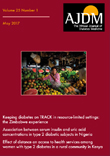Glucagon like peptide receptor agonists lowers glucose levels through direct and indirect effects on multiple organs
*Corresponding Author:
Received: 29-Mar-2023, Manuscript No. AJDM-23-97643; Editor assigned: 31-Mar-2023, Pre QC No. AJDM-23-97643 (PQ); Reviewed: 14-Apr-2023, QC No. AJDM-23-97643; Revised: 19-Apr-2023, Manuscript No. AJDM-23-97643 (R); Published: 26-Apr-2023
Introduction
As the number of people with type 2 diabetes increases, there has been a need in recent decades for antidiabetic drugs that are effective and have a low risk of hypoglycemia, especially in aging societies. Dipeptidyl Peptidase-4 (DPP-4) inhibitors are widely used, especially in East Asia, and are the most commonly used antidiabetic drugs in Japan due to their safety and lack of adverse effects on body weight. In addition to their safety, multiple reports demonstrate the efficacy of the drugs in individuals. Although the risk is not as high, bullous pemphigoid is one of this DPP-4 inhibitor AEs to watch out for. A recent report showed an increased risk three months after first using a DPP-4 inhibitor. In addition to the safety and efficacy of DPP-4 inhibitors, a meta-analysis of randomized trials found that Glucagon-Like Peptide-1 Receptor Agonists (GLP-1RA) increased the risk of serious adverse cardiac events, all causes of death. It has been shown to reduce mortality.
Description
Hospitalization with consequent heart failure and combined renal, without increased side effects. In addition to its protective effects on cardiovascular disease and renal function, GLP-1RA can reduce body weight. GLP-1RA lowers glucose levels through direct and indirect effects on multiple organs including the central nervous system, heart, arteries, kidneys, liver and pancreas. A recent systematic review and meta-analysis showed that GLP-1RA significantly reduced both visceral and subcutaneous adipose tissue, with the reduction of visceral adipose tissue being greater than that of subcutaneous adipose tissue compared with controls was also shown. GLP-1RA is an attractive alternative to bolus insulin injections, especially for obese patients with type 2 diabetes, because of its low risk of hypoglycemia and its weight-loss effect. A recent report showed that simplification of an intensive insulin injection regimen (basal and bolus insulin injections) to liraglutide resulted in stable glucose excursions in well-controlled type 2 diabetic patients receiving multiple daily insulin injections associated HbA1c levels were shown to be preserved. In addition, replacement therapy decreased total insulin dose and quality of life scores, which were highly related to injection frequency.
Even one daily injection can be difficult for some elderly diabetics. Under these circumstances, the use of GLP-1 weekly RA was approved in Japan. In the sustainability of semaglutide in the treatment of type 2 diabetes study, weekly semaglutide injections improved glycemic control, significantly reduced body weight and waist circumference, It was shown to reduce the incidence of serious heart disease than a placebo or comparator. Type 2 diabetic patients from East Asian countries are characterized by lower Body Mass Index (BMI) attributed to dysfunction and relatively lower insulin-secreting capacity compared to caucasians.
Conclusion
DPP-4 inhibitors may be preferred among incretin-related agents for her elderly type 2 diabetic patients because they have a low risk of hypoglycemia, are effective in lowering HbA1c, and are weight neutral. There is a nature in contrast, GLP-1RA shows greater efficacy in lowering HbA1c and significantly reducing body weight. It also offers patients multiple dosing methods, including one or two daily injections, weekly injections and oral administration. In addition, it may also have a protective effect against atherosclerosis. Therefore, it can be used in obese patients who are at high risk for diabetes and cardiovascular disease.
Acknowledgement
None.
Conflict of Interest
The author has nothing to disclose and also state no conflict of interest in the submission of this manuscript.





